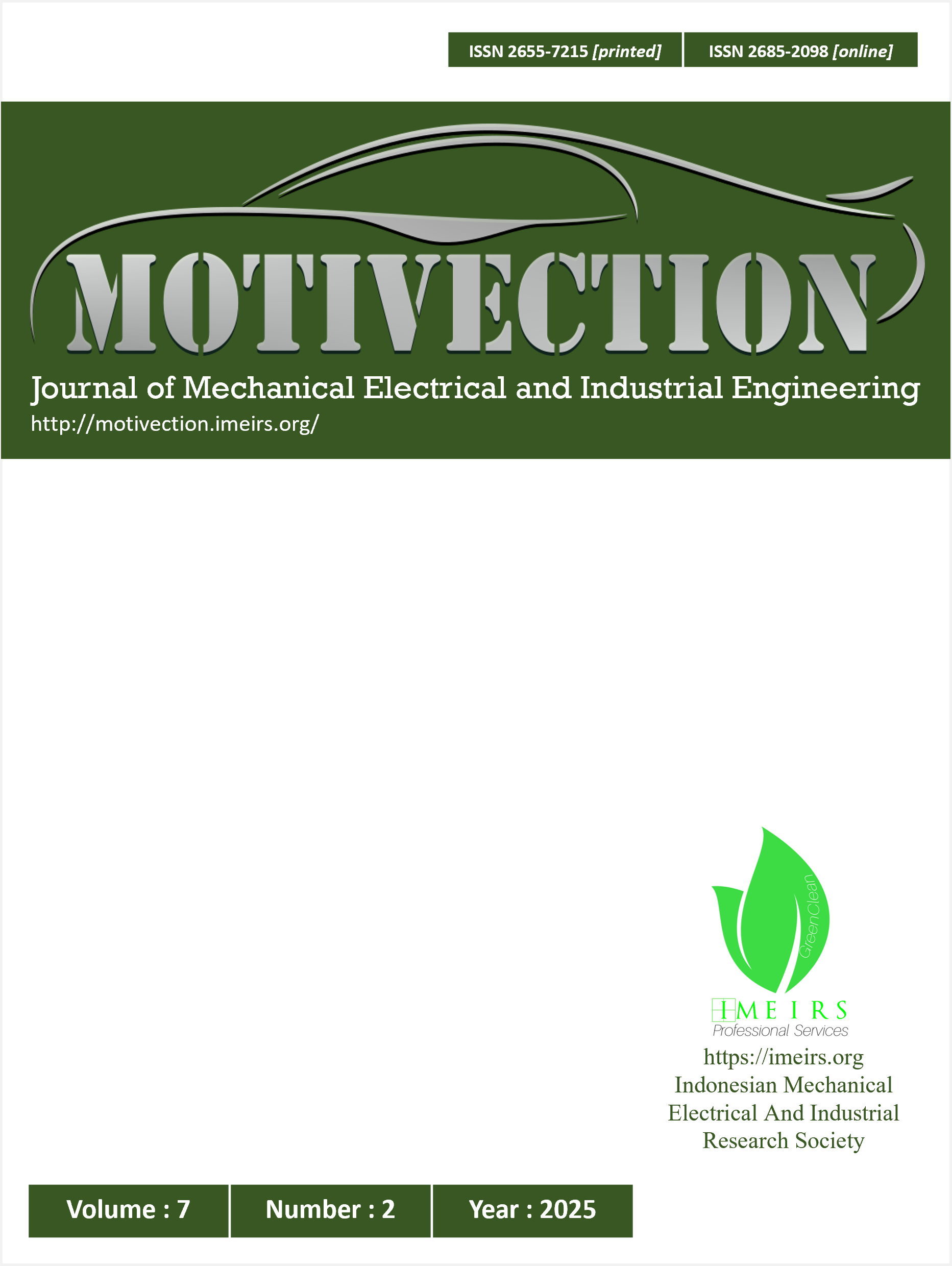Implementation of Finite State Automata for 6-Axis Robot in the Screwing Process
##plugins.themes.academic_pro.article.main##
Abstract
The screwing process is one of the important stages in the assembly of industrial products that requires high precision and time efficiency. This study implements Finite State Automata using Nondeterministic Finite Automata with the Mealy Machine model. The implementation of Finite State Automata on a 6-axis robot in the screwing process allows for better control, because each step in the process can be analyzed and programmed clearly. The system is controlled by a programmable logic controller that integrates a 6-axis robot, human machine interface, screwdriver, sensors, and pneumatic actuators. The screwing process is carried out using an automatic screwdriver, with the robot's movement following a logical sequence based on the Mealy Machine model state diagram. Each state represents the robot's operational steps, from taking tools, screws, to the screwing process. The study focuses on designing a system to move the robot according to the state diagram that activates the output based on the state transition to the input. The results show that the implementation of Finite State Automata is able to complete the screwing process consistently and repeatedly. This system also considers safe points to avoid collisions, thus supporting safety in the screwing process. The application of Finite State Automata on 6-axis robots is expected to provide convenience for users in understanding robot control in the screwing process and can be implemented according to industrial needs.
##plugins.themes.academic_pro.article.details##

This work is licensed under a Creative Commons Attribution 4.0 International License.
Copyright (c): Rapis Nursalam, Risfendra Risfendra, Eko Purnama, Defri Defri (2025)References
[2] L. H. Adha, Z. Asyhadie, and R. Kusuma, “Digitalisasi Industri Dan Pengaruhnya Terhadap Ketenagakerjaan Dan Hubungan Kerja Di Indonesia,” J. Kompil. Huk., vol. 5, no. 2, pp. 267–205, Dec. 2020, doi: 10.29303/jkh.v5i2.49.
[3] Sukardi, H. Setyawan, Risfendra, Usmeldi, and D. T. P. Yanto, “Effectiveness of Robotic Technology in Vocational Education: A Meta-Analysis,” Int. J. Inf. Educ. Technol., vol. 14, no. 4, pp. 521–532, 2024, doi: 10.18178/ijiet.2024.14.4.2073.
[4] A. Wiyono, I. Rokhim, and A. Sumardi, “Robot Lengan Untuk Proses Perakitan Miniatur Body Mobil Sebagai Media Pembelajaran Robotika,” Semin. Nas. Teknol. Dan Ris. Terap., vol. 1, no. September, pp. 65–72, 2019.
[5] G. Sandhika Putra and Risfendra, “Sistem kontrol lengan robot berbasis Arduino dengan aplikasi GUI,” JTEIN J. Tek. Elektro Indones., vol. 3, no. 2, pp. 387–398, 2022, doi: 10.24036/jtein.v3i2.270.
[6] M. Sága, V. Bulej, N. Čuboňova, I. Kuric, I. Virgala, and M. Eberth, “Case study: Performance analysis and development of robotized screwing application with integrated vision sensing system for automotive industry,” Int. J. Adv. Robot. Syst., vol. 17, no. 3, pp. 1–23, 2020, doi: 10.1177/1729881420923997.
[7] R. Naboni, A. Kunic, A. Kramberger, and C. Schlette, “Design, simulation and robotic assembly of reversible timber structures,” Constr. Robot., vol. 5, no. 1, pp. 13–22, 2021, doi: 10.1007/s41693-020-00052-7.
[8] K. Anja, R. Naboni, A. Kramberger, and C. Schlette, “Design and assembly automation of the Robotic Reversible Timber,” 2021, doi: 10.1016/j.autcon.2020.103531.
[9] M. Siska, I. Siregar, A. Saputra, M. Juliana, and M. T. Afifudin, “Kecerdasan Buatan dan Big Data dalam Industri Manufaktur: Sebuah Tinjauan Sistematis,” Nusant. Technol. Eng. Rev., vol. 1, no. 1, pp. 41–53, 2023, doi: 10.55732/nter.v1i1.1119.
[10] R. Balogh and D. Obdržálek, “Using Finite State Machines in Introductory Robotics,” Adv. Intell. Syst. Comput., vol. 829, no. April, pp. 85–91, 2019, doi: 10.1007/978-3-319-97085-1_9.
[11] I. El Makrini, M. Omidi, F. Fusaro, E. Lamon, A. Ajoudani, and B. Vandcrborght, “A Hierarchical Finite-State Machine-Based Task Allocation Framework for Human-Robot Collaborative Assembly Tasks,” IEEE Int. Conf. Intell. Robot. Syst., vol. 2022-October, pp. 10238–10244, 2022, doi: 10.1109/IROS47612.2022.9981618.
[12] A. S. Maulana, “Implementasi Finite State Automata (FSA) dengan Simulasi Vending Machine pada Aplikasi Android,” J. Edukasi Elektro, vol. 3, no. 2, pp. 110–120, 2020, doi: 10.21831/jee.v3i2.28332.
[13] M. F. Rahadian, A. Suyatno, and S. Maharani, “Penerapan Metode Finite State Machine Pada Game ‘The Relationship,’” Inform. Mulawarman J. Ilm. Ilmu Komput., vol. 11, no. 1, p. 14, 2016, doi: 10.30872/jim.v11i1.198.
[14] R. Agastya Nugraha, Yanto, A. Mulyani, and W. Gata, “IJCIT (Indonesian Journal on Computer and Information Technology) Desain Vending Machine Rujak Buah Dengan Finite State Automata,” IJCIT (Indonesian J. Comput. Inf. Technol., vol. 5, no. 2, pp. 198–207, 2020, doi: 10.31294/ijcit.v5i2.8169.
[15] S. Prithi and S. Sumathi, “A technical research survey on bio-inspired intelligent optimization grouping algorithms for finite state automata in intrusion detection system,” Int. J. Eng. Sci. Technol., vol. 16, no. 2, pp. 48–67, 2024, doi: 10.4314/ijest.v16i2.6.
[16] A. D. Marzooqa, F. S. Yumna, F. L. Hafizh, and T. Setiadi, “Jurnal JTIK ( Jurnal Teknologi Informasi dan Komunikasi ) Implementasi Vending Machine Ramen dengan Menggunakan,” vol. 9, no. September, pp. 896–905, 2025.
[17] A. P. Giovani, F. Zamachsari, E. D. Agustono, M. I. Prasetya, and W. Gata, “Implementasi Finite State Automata Dalam Siklus Pembelajaran Magister Ilmu Komputer STMIK Nusa Mandiri,” CESS (Journal Comput. Eng. Syst. Sci., vol. 5, no. 2, p. 221, 2020, doi: 10.24114/cess.v5i2.16696.
[18] M. H. Jihad, T. Andromeda, and S. Sudjadi, “Aplikasi Pengendalian Arm Manipulator 4 Dof Menggunakan Algoritma Finite State Machine Sebagai Pemindah Sayuran Pascapanen Terozonisasi,” Transient, vol. 7, no. 3, p. 782, 2019, doi: 10.14710/transient.7.3.782-788.
[19] Y. Zhan and M. S. Hsiao, “Formal validation for natural language programming using hierarchical finite State Automata,” ICAART 2021 - Proc. 13th Int. Conf. Agents Artif. Intell., vol. 1, no. Icaart, pp. 506–518, 2021, doi: 10.5220/0010388905060515.
[20] E. Engler, M. Baldauf, F. S. Torres, and S. Brusch, “Finite state machine modelling to facilitate the resilience of infrastructures: Reflections,” Infrastructures, vol. 5, no. 3, 2020, doi: 10.3390/infrastructures5030024.
[21] B. Sutjiono and I. Nyoman, “Improvement Proses Screwing pada Lini Kaleng Kopi di PT Sinar Djaja Can,” vol. 6, no. 1, pp. 15–20, 2018.
[22] N. Khesya, “Mengenal Flowchart Dan Pseudocode Dalam Algoritma Dan Pemrograman,” Definitions, 2020, doi: 10.32388/tf77dy.

